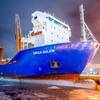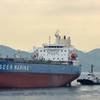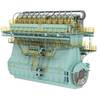Demonstrating a long-term commitment to its U.K. industrial base, Vosper Thornycroft is scheduled to start production next spring at a new, £40-million ($60-million) shipbuilding facility being created within the Portsmouth Naval Base.
The technologically advanced, undercover yard will cut its teeth on the Royal Navy's Type 45 destroyer program, constructing pre-outfitted blocks of up to 700-ton steelweight for ship assembly elsewhere in the U.K. at yards controlled by BAE Systems.
Described as a shipbuilding factory, in keeping with investments in state-of-the-art production machinery and a layout and logistic arrangements conducive to high productivity, the Portsmouth facility will have the capacity to turn out mega-blocks of up to 6,000-tons, as envisaged for the RN's next generation of aircraft carriers.
Although the yard will initially comprise two, 426-ft. (130-m), fully-enclosed shipbuilding bays and a 10,000-sq.m. production hall, the site provides for subsequent expansion. The circumspect nature of the design project not only reflects Vosper Thornycroft's long-range view of the international naval market, but also its perception of opportunities in the commercial sector. Last year's unveiling of a development project for a 476-ft. (145-m) wave-piercing catamaran RoPax ferry underscored the company's multi-faceted business strategy.
The Portsmouth factory is truly a milestone for the industry in the U.K., where decades of contraction in shipbuilding have obscured the achievements and resilience of the remaining players. Moreover, it will provide an outstanding example of the manner in which modern-day shipbuilding has embraced sophisticated technology, contrary to ill-conceived notions in western society of traditional industries being locked into outmoded ways of working and thinking.
"This facility will be among the most modern shipyards in the world," confirmed VT's CEO Martin Jay. "The processes will be highly automated and will enable us to make productivity advances that will help to secure further shipbuilding orders in the U.K. and in our export markets," he added.
Besides the installation of new, faster CNC laser plate cutting machinery and a steel panel line with 10 workstations and a semi-automatic, single-sided seam welder, equipment will be transferred from VT's current, main shipbuilding yard at Woolston, Southampton, which is to cease shipbuilding. Much of the advanced manufacturing wherewithal will be concentrated in the steel production hall, which will focus on cutting, profiling and fabrication activities.
One of the new yard's two 426-ft. (130-m) shipbuilding bays will be established on an area prepared by infilling an existing graving dock, and will have the potential for extension by a further 230-ft. (70-m). Moreover, the site could be augmented with a third newbuild berth, by infilling another, adjoining drydock to create a bay up to 623 ft. (190 m).
In the initial configuration, the two shipbuilding bays will be complemented by the availability of at least one drydock specifically for outfitting.
Portsmouth's debut contract for work on the first six Type 45 destroyers will be worth in excess of £200-million ($300-million) to VT, through its involvement in the design and support as well as production stages of the project. The blocks to be supplied will comprise the bow section, funnel and masts. It is planned that the class will eventually consist of up to 12 ships.
Cutting Edge Know-How
to Cut Smoke
As a further vindication of major Greek investment in marine propulsion research, the state-of-the-art, engine test laboratory inaugurated less than two years ago at the National Technical University of Athens (NTUA) will contribute to a new European project to reduce diesel engine smoke emissions.
Co-ordinated by the Greek CIMAC Association, the EU-sponsored collaborative research program, dubbed Smokermen, was implemented at the outset of July this year, with an intended 36-month duration. The NTUA's Laboratory of Marine Engineering will lend its experimental testing resources and mathematical modeling expertise to the endeavor, which aims to cut smoke emissions to below the visible limit in transient and low-load conditions.
The EU is providing around 50-percent funding support for the ambitious project, which also involves partners from Germany, the Netherlands and Switzerland, in the shape of classification society Germanischer Lloyd, engine control systems specialist Woodward Governor Nederland and turbocharger maker ABB Turbo Systems. Smokermen is focused on medium-speed and high-speed diesel plant, and aims to curb smoke formation during the critical load phases by improving the air-charging of main and auxiliary engines.
The impulse for the program has come from shipping company members of the Greek chapter of CIMAC, who have raised concerns over engine smoke emissions, aware of the growing environmental sensitivities associated with smoke from ships' stacks. Greek CIMAC members also intend to make vessels available for onboard measurements, a vital part of the research undertaking.
The project will evaluate two technologically-advanced solutions to the problem of fuel-air mismatch, which manifests itself during transient loading and leads to increased smoke output.
Two prototype systems and the respective engine control arrangements will be developed and installed on a marine diesel engine on a testbed, to evaluate performance. The techniques, which will be used for the prototypes, will be high-pressure air injection to accelerate the turbocharger and feed the engine at the onset of a transient load condition, and advanced pulse turbocharging with variable geometry manifold.
A key objective with Smokermen is to formulate systems that are suitable not only for new seagoing installations, but also for retrofitting to most of the existing population of medium-speed and high-speed diesels.
Subscribe for
Maritime Reporter E-News
Maritime Reporter E-News is the maritime industry's largest circulation and most authoritative ENews Service, delivered to your Email five times per week












